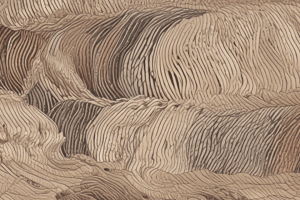Podcast
Questions and Answers
What is the primary way to harvest cotton fibres?
What is the primary way to harvest cotton fibres?
- Shearing
- Carding
- Ginning (correct)
- Sericulture
What is the purpose of carding in the processing of natural fibres?
What is the purpose of carding in the processing of natural fibres?
- To brush fibres to align them in the same direction (correct)
- To interlace yarns to create fabric
- To stretch the fibres to align molecular structure
- To create a continuous thread
Which of the following is a characteristic of synthetic fibres?
Which of the following is a characteristic of synthetic fibres?
- Obtained from plants and animals
- Produced through sericulture
- Harvested through shearing
- Made from chemical compounds (correct)
What is the term for the ability of a fibre to resist wear and tear?
What is the term for the ability of a fibre to resist wear and tear?
What type of fabric is created through bonding or felting?
What type of fabric is created through bonding or felting?
Flashcards are hidden until you start studying
Study Notes
Natural Fibres
- Obtained from plants and animals
- Examples:
- Plant fibres: cotton, jute, flax, hemp
- Animal fibres: wool, silk, cashmere, mohair
Production of Natural Fibres
- Cotton:
- Grows around seeds of cotton plant
- Harvested through ginning (separating cotton fibres from seeds)
- Wool:
- Obtained from sheep and other animals
- Harvested through shearing (cutting of wool fibres)
- Silk:
- Produced by silkworms
- Harvested through sericulture (rearing of silkworms)
Processing of Natural Fibres
- Carding:
- Brushing fibres to align them in the same direction
- Produces a rope-like strand called a sliver
- Spinning:
- Drawing out the sliver to create a continuous thread
- Twisting the thread to create yarn
- Weaving or knitting:
- Interlacing yarns to create fabric
- Can be done using a loom or needles
Synthetic Fibres
- Made from chemical compounds
- Examples: polyester, nylon, acrylic, polyamide
Production of Synthetic Fibres
- Extrusion:
- Melting and forming chemical compounds into long strands
- Texturizing:
- Crimping or twisting the strands to create texture
- Drawing:
- Stretching the strands to align molecular structure
Properties of Fibres
- Strength: ability to resist breaking
- Elasticity: ability to stretch and return to original shape
- Durability: ability to resist wear and tear
- Breathability: ability to allow air to pass through
- Softness: texture of the fibre
Fabric Types
- Woven fabrics: created through weaving (e.g. cotton, polyester)
- Knitted fabrics: created through knitting (e.g. wool, nylon)
- Non-woven fabrics: created through bonding or felting (e.g. fleece, felt)
Natural Fibres
- Obtained from plants and animals
- Plant fibres: cotton, jute, flax, hemp
- Animal fibres: wool, silk, cashmere, mohair
Cotton Production
- Grows around seeds of cotton plant
- Harvested through ginning, which separates cotton fibres from seeds
Wool Production
- Obtained from sheep and other animals
- Harvested through shearing, which involves cutting of wool fibres
Silk Production
- Produced by silkworms
- Harvested through sericulture, which involves rearing of silkworms
Fibre Processing
- Carding: brushing fibres to align them in the same direction, producing a rope-like strand called a sliver
- Spinning: drawing out the sliver to create a continuous thread, and twisting the thread to create yarn
- Weaving or knitting: interlacing yarns to create fabric, which can be done using a loom or needles
Synthetic Fibres
- Made from chemical compounds
- Examples: polyester, nylon, acrylic, polyamide
Synthetic Fibre Production
- Extrusion: melting and forming chemical compounds into long strands
- Texturizing: crimping or twisting the strands to create texture
- Drawing: stretching the strands to align molecular structure
Fibre Properties
- Strength: ability to resist breaking
- Elasticity: ability to stretch and return to original shape
- Durability: ability to resist wear and tear
- Breathability: ability to allow air to pass through
- Softness: texture of the fibre
Fabric Types
- Woven fabrics: created through weaving, examples include cotton and polyester
- Knitted fabrics: created through knitting, examples include wool and nylon
- Non-woven fabrics: created through bonding or felting, examples include fleece and felt
Studying That Suits You
Use AI to generate personalized quizzes and flashcards to suit your learning preferences.




